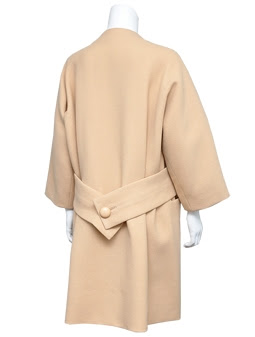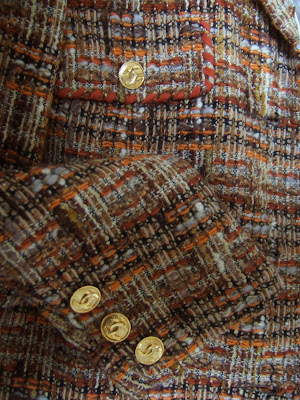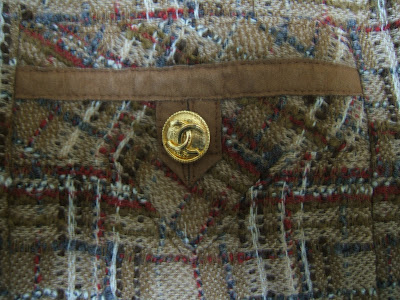 1960s magazine ad for Balenciaga perfume
1960s magazine ad for Balenciaga perfume
I recently had the opportunity to examine a superb vintage Balenciaga day coat at the flagship of Toronto’s Holt Renfrew. Canada’s most prestigious clothing retailer, Holt Renfrew, was founded in 1837 in Quebec, and has held royal warrants, such as furrier to Queen Victoria. In the late 20th century, as furs were seen less frequently, and were viewed as politically problematic, the store became better known for supplying designer and other fine clothing and accessories for men and women. Among the brands carried are Christian Dior (a relationship starting in the late 1940s when Dior himself visited the store and Toronto social scene), Chanel, Gucci, Saint-Laurent, Moschino, Oscar de la Renta, Dolce & Gabbana, Ralph Lauren, Louis Vuitton, and Roger Vivier. In keeping with the times, and the popularity of vintage clothing, they have offered a diminutive, exclusive collection of pieces by vintage dealer Linda Latner of Vintage Couture. The collection consists of a single rack, but is of such quality and so carefully selected,
or curated, that it is always a pleasure to view. This is the closest one can physically get to museum quality vintage couture.
Some months ago, I was particularly intrigued by this superb, mid 1960s Balenciaga couture coat offered at Holt's. Interestingly, it had been first retailed by Holt Renfrew, the same store selling it now, some 45 years ago. Apart from this fascinating historic detail, the coat in itself is an exemplary piece of Balenciaga, the type that connoisseurs and curators of fashion admire. Typically, in the 40s, 50s, and 60s, a few select pieces of couture were brought in, and promoted by top retailers such as Bergdorf's, Saks, and Neiman-Marcus in the United States, Harrods in London, and Eaton's, Simpson's, Creed's, and Holt Renfrew in Canada. They were often featured in illustrated, full page newspaper ads, and would create an exclusive buzz while demonstrating a trend, colour, or theme for the season that was available in the store's less expensive lines. Sometimes, a couture example was reproduced as ready-to-wear, at a much lower price, but with a certain cachet of having the design reproduced or adapted from an exclusive Paris model.
In the mid 1960s, Balenciaga clothes reached an amazing level of skill and design evolution. The clothes were simple and wearable, but very original. Balenciaga believed in simplicity as a form of dignity. Many consider the clothes almost monastic in feeling, reminiscent of liturgical robes, ecclesiastical garments, and religious habits. Balenciaga was partial to heavy, costly fabrics that had body and structure. His designs were simply cut so as to show the quality and beauty of the fabric.
For aficionados who appreciate cut and couture, this day coat deserves closer examination. It is boxy and cut away from the body. It is pieced in large horizontal panels, giving a slightly segmented feeling, especially when it is worn. It has an ease and generous feel that was the antitheses of the corseted, cantilevered, padded and shaped 1950s Christian Dior ideal a decade earlier. The narrowest horizontal panel, about 4” wide, is at waist level (the bottom edge is also the opening to the left and right slash pockets), and becomes a loose, drape-y half belt at the back that holds in the fabric folds in soft box pleats. In a medium weight wool with an almost felt like surface, and in a quiet cream, this is luxurious Paris couture in the most discreet manner. Considering the great expense of Paris couture, a coat like this which sits away from the body, and would actually fit a range of sizes and weight fluctuations, might be considered a better investment than a fitted, limited use, gala gown.
In considering such a design, one should imagine it in different fabrics and colours, just as Wallis Simpson did with her favorite couture models. She is known to have pleasantly surprised Dior himself by reordering one of his own models in an entirely different colour and material. This would be a bewitching evening coat in black or raspberry heavy matte satin. It could be a beautiful spring coat in hot pink mohair. A Donegal or Linton tweed example would be wonderful in fall. Black wool serge or gaberdine would make it the ultimate all purpose coat.
Looking at a really fine couture example such as this, it is understandable that the elite of the 1950s and 1960s, women like Mona Bismarck and Bunny Mellon, ordered several versions for various residences, and in different colours for variety. One is struck by the balance, proportion, and taste of such a design, and yet it has a retiring aspect. Balenciaga clothes are as much about the wearer as they are about the garment, and they have a sense of modesty that is ennobling.
One cannot help but wonder why a stylist or design studio didn't acquire this piece. Top design houses are known to take vintage pieces as "inspiration." It certainly wouldn't have been out of place in a well edited Prada, Jil Sander, or Marc Jacobs collection. With a price similar to a new Chanel jacket, I don't think that such a rare and exceptional piece is unreasonable, but then stylists of the world don't usually think of Toronto as a destination for superb vintage couture.
I agree with fashion historians who have assessed Balenciaga as the greatest couturier, and I’ve seen many incredible pieces in museums, private collections, and books, but this has to be one of my favourites. Because it is such a superb example, and is a document of the way Paris couture was disseminated to far away, sparsely populated Canada, I would loved to have seen it go to the fashion collection of the ROM, Seneca College, or the Musée des beaux-arts de Montréal. But least I have photos and got to hold it in my hands, and in a way, that was better than viewing it behind glass and in obligatory archival
low light conditions.
Many thanks to Lynda Latner for generously sharing the images, and for sleuthing out such a masterpiece.
http://www.vintagecouture.com/Images courtesy of Lynda Latner of Vintage Couture  mid 1960s cream wool Balenciaga coat
mid 1960s cream wool Balenciaga coat
 detail of back of Balenciaga coat; note the elegant yet casual draping and the way the back panel is one with the sleeves (cut Raglan style at the front)
detail of back of Balenciaga coat; note the elegant yet casual draping and the way the back panel is one with the sleeves (cut Raglan style at the front)
 these wonderful large buttons, so simple and beautifully proportioned for the coat design, remind me of French macarons from Ladurée
these wonderful large buttons, so simple and beautifully proportioned for the coat design, remind me of French macarons from Ladurée
 the labels of Balenciaga and Holt Renfrew that connect the old and new world with couture
the labels of Balenciaga and Holt Renfrew that connect the old and new world with couture
 recent model Cadillac SUV
recent model Cadillac SUV the Cadillac Escalade hearse is very similar to the big black Cadillacs people use for getting to work and shopping
the Cadillac Escalade hearse is very similar to the big black Cadillacs people use for getting to work and shopping


















































